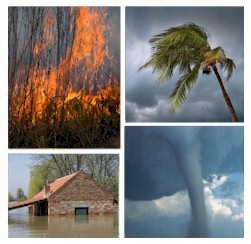|
|


Emergency Notification Systems and Services
 This section of our technical library presents articles written about Emergency Alert Systems and Disaster Recovery definitions, terms and related information.
This section of our technical library presents articles written about Emergency Alert Systems and Disaster Recovery definitions, terms and related information.
The 911Broadcast emergency notification and alert service can deliver a large number of phone calls using a network of phone systems employing digital phone lines simultaneously. Should a disaster such as a snow storm, wild fire or flood hit your area, 911Broadcast systems can alert your community quickly providing specific instructions if an evacuation is required.
This service is available using our emergency broadcasting systems. If a dangerous chemical spill occurs in your community, you can target specific areas to call. If a severe snow storm hits your area, your community can be notified of school closings or event cancellations.
Coalition Uses Web for Emergency Notification
System uses Web services, off-the-shelf software
By Grant Gross, IDG News Service
The 9-1-1 emergency service in Oregon has expanded to include instant notifications to school administrators, hospitals and other people who need timely emergency notifications, thanks to a coalition of Oregon local governments and technology vendors using Web services and off-the-shelf software.
On Wednesday, the Regional Alliances for Infrastructure and Network Security (RAINS) launched its RAINS-Net technology platform, which sends live emergency information to selected users over the Internet and by cell phone. The creators of RAINS-Net are billing it as an extension of 9-1-1 service, in which the existing computer-aided dispatch system is connected to the Internet and sends alerts to officials who need to know about emergency situations in their neighborhoods.
RAINS-Net, linked in this case to the Portland, Oregon, 9-1-1 center, automatically sends out the alerts without dispatchers doing any more work than they would to notify the appropriate response agency, such as a fire department or police department. "The operator doesn't do anything except what they're doing today," said Charles Jennings, a RAINS board member and chairman and chief executive officer of sponsoring vendor Swan Island Networks. "It adds no new human resources element to the dispatch center."
Launched 16 months ago as a response to the Sept. 11, 2001, terrorist attacks on the U.S, the RAINS-Net project was funded with only $60,000 in grants from the state of Oregon and private company sponsorships. Founders also envision the RAINS coalition as boosting economic development in Oregon and surrounding states by developing technologies that can be used elsewhere, Jennings said. Sixty companies and six universities are involved in the RAINS coalition, he added, and four other states have either started a RAINS group or are talking to the Oregon coalition about it.
"We thought there would be the opportunity to develop new homeland security systems," Jennings said. "We decided to take an active, 'let's-build-it approach' as opposed to just creating white papers and policy."
The group acted on advice from Senator Ron Wyden, an Oregon Democrat, who said if the group wanted support from Washington, D.C., it should approach lawmakers and bureaucrats with a working product, not a blueprint. In looking to design products that aid domestic security, the coalition decided to tackle the problem of information sharing between emergency responders and the public.
The creators of RAINS-Net believe it is the first project to capture real-time data in a 9-1-1 centerís local information system, and redistribute it broadly to those responsible for public safety in a community, Jennings added.
Here's how RAINS-Net works: When a 9-1-1 call comes into a dispatch center, the information an operator types into the dispatch center computers can be routed to a cell phone message or a pop-up dialog box on a PC. In the case of an emergency event like a hazardous waste spill, those people on the RAINS-Net network would be notified immediately, and the dialog box might direct them to additional multimedia information, such as a video on how to respond to a hazardous waste spill. The RAINS-Net system, which goes live on Thursday, already has about 1,000 files that provide additional information on emergency situations.
In some cases, such as a crime in progress, the RAINS-Net system would wait until police show up on the scene before notifying people on the network, so that police can assess the situation before raising concerns, Jennings said.
The system uses the nine-digit zip code to route messages to recipient, so that a school in one neighborhood wouldn't get an emergency message about a fire across town. The system also has the capability of sending out city-wide emergency messages to appropriate recipients.
RAINS-Net initially integrates the technologies of RAINS sponsor companies, including FORTiX, Tripwire, Centerlogic, and Jennings' Swan Island Networks by using XML and Web services. More companies are working with RAINS to integrate their technologies into the RAINS-Net as new capabilities are added.
The RAINS-Net platform is a client-server application built from commercial, off-the-shelf technologies that runs on top of existing networks, according to RAINS. The coalition touts the package as a highly secure way to send sensitive information to community members selected by RAINS; information from RAINS-Net canít be copied, forwarded, edited or printed by recipients, unless authorized by the sender.
RAINS-Net is originally aimed at notifying school administrators, building managers and hospitals of emergency situations in their neighborhoods, but the RAINS coalition plans to expand the number of recipients to include government officials, utility companies and other groups that are part of a community's critical infrastructure, Jennings said.
The ultimate goal of RAINS, Jennings said, is to link up high-tech innovators with emergency responders, research universities, public officials and others concerned with domestic security. "A lot of times, high-tech and everybody else are in two different camps," he said. "It's my contention that particularly in the information-sharing arena, the only way you get progress and traction is by having the tech people and the policy people and responders in the same room working together."
Crime Alerts - Emergency Dialer For Crime Warnings
 If a crime should threaten your community, our telephone warning system can notify your neighborhoods immediately. With our emergency notification phone service, you can broadcast warning messages to thousands of households in your community warning of a criminal activity that requires resident notification.
If a crime should threaten your community, our telephone warning system can notify your neighborhoods immediately. With our emergency notification phone service, you can broadcast warning messages to thousands of households in your community warning of a criminal activity that requires resident notification.
Messages can be simultaneously delivered in just minutes using our network of phone systems and services. Pre-recorded warning messages can be played giving households information regarding a criminal alert and whether residents need to remain at home or evacuate a particular neighborhood. You can send a broadcast warning to specific neighborhoods or communities in the event of this type of criminal activity and provide priority delivery of these messages to those nearest crime scene. Multiple messages can be delivered to different members of the community based upon proximity to the area of the crime. Calls can be directed to operators that are standing by to handle special individual emergencies.
Messages can also be broadcast seeking volunteers or special assistance from emergency personnel.
Remote communities have used this technology to warn residents when a criminal is operating in their community. A more immediate use is when there has been an abduction of an individual, notifying the immediate neighborhood to be on the lookout for the criminal and the victim.
Other applications include warning residents when the danger of a crime is higher based on criminal intelligence. Travel and activity restrictions can likewise be broadcast using this service.
Messages warning of crime activity sent to households in this fashion can be simple warnings with specific or general instructions. If the community needs feedback from the call, an interactive response can be programmed into the message allowing the person to either acknowledge the call or to contact someone. Messages can vary based upon proximity to the event, with different degrees of broadcast warning and instructions.
To learn more about our alert and emergency response and disaster recovery phone service, please visit our Emergency Broadcast System web page.
Contact DSC Today for a FREE analysis and quote and to learn more about our forest fire alert and emergency notification services.
|




 This section of our technical library presents articles written about Emergency Alert Systems and Disaster Recovery definitions, terms and related information.
This section of our technical library presents articles written about Emergency Alert Systems and Disaster Recovery definitions, terms and related information.
 If a crime should threaten your community, our
If a crime should threaten your community, our